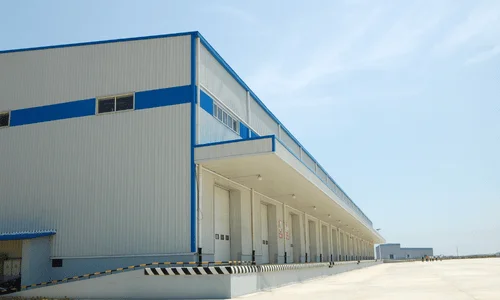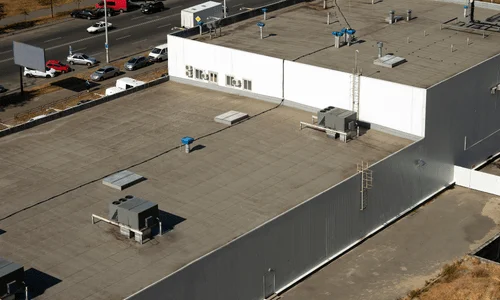TPO vs. EPDM Roofing: What is the Difference & How to Choose

If you’re a business owner considering a new roof, you may wonder what the difference is between TPO and EPDM roofing. Possibly, you have never heard of either. To understand what option is best for your business and roof longevity, you must first know the TPO and EPDM abbreviations and how each product benefits your facility. While both are durable options with different benefits, one might be better for your current situation. Matute Roofing can guide you in the right direction. Our trained staff understand the importance of making the right roofing choices and are here to help. In the meantime, here’s a quick business owners’ guide to the differences between TPO and EPDM roofing. Let us help you make the right choice.
Differences Between TPO vs. EPDM Roofing
When it comes to replacing a commercial or industrial building’s roof, TPO and EPDM are two of the most popular options. TPO and EPDM roofs have unique features, so the best option depends on the facility’s needs. TPO (Thermoplastic Polyolefin), introduced
in the early 90s, is a single-ply, lightweight, and economical option for commercial roofing. It was developed as an alternative to rubber and PVC roofs and composed of 3 layers (a TPO polymer base, a polyester-reinforced scrim, and a TPO compounded top ply). As one of the fastest-growing roofing systems on the market, TPO makes up an estimated 40% of the commercial market, according to a National Roofing Contractors Association report. Its strength lies in its ability to resist chemicals, UV radiation, punctures, and tears while remaining cost-effective.
On the other hand, EPDM (Ethylene Propylene Diene Terpolymer) is an older, more durable rubber sheet material with excellent stand-up time in harsh weather situations. It’s more resistant to punctures and tears than TPO but may be slightly less durable against UV and chemicals. Its two primary ingredients, ethylene and propylene, are derived from oil and natural gas. An EPDM rubber roof is easier and faster to install than a TPO roofing membrane. EPDM requires no special installation equipment, while TPO must be hot air welded, making a TPO roofing membrane installation a more complex and costly process. Depending on specific needs for a roofing system, TPO or EPDM are both viable options for choice.
The Pros and Cons of TPO Roofing
TPO roofing is a commercial roofing solution that continues to gain popularity due to its numerous advantages. It’s an effective solution for commercial roofs because it offers excellent waterproofing capabilities and can withstand plenty of wear and tear without being too taxing on the budget. However, the downside of TPO roofing is that manufacturers produce widely varying versions of TPO products. One may produce a superior product at a specific price point, and another may produce an inferior one at that same price. Another issue with TPO roofing is that it is sold in small-width rolls, which means seams are present every six to eight feet on more extensive commercial roofs. Contractions and expansions occur in the membranes, and the seams are often areas where the membranes become loosened, leading to water leaks. TPO roofing membranes may be more expensive than the other EPDM membranes.
The Pros and Cons of EPDM Roofing

EPDM roofing is a popular choice for low-sloped or flat roofs due to its cost-effectiveness and easy installation. While this type of roofing can be an excellent option for many projects, like any product, it does have drawbacks. EPDM roofs have a solid reputation for durability and have been on the market for decades. Made of a rubber compound, an EPDM roof can last up to 25 years if installed properly with tapered seams and detailed flashings. EPDM is a dependable roofing material offering resistance against ultraviolet light, ozone, oxidants, and severe weather conditions. It is an exceptional product if you experience a lot of hail storms and live in a cooler climate. Ultimately, the decision between TPO vs. EPDM should come down to the particular needs of each project and a thorough examination of both materials’ benefits and drawbacks.
TPO vs. EPDM for Your Business – How to Choose
Choosing commercial roofing is a big decision that can affect the look and longevity of your facility. There are many things to consider when deciding on the right kind of commercial roofing, such as the weather conditions in your area, your budget, and the type of material you prefer. With so many options available, narrowing down what’s best for your needs can be daunting. To make the right choice, research your location’s climate and environmental conditions, assess pricing based on material availability for commercial roofing, and decide which material will provide a long-lasting solution. Matute Roofing, a trusted professional team, can work with you to help with product selection, installation, and maintenance.
Tips for Maintaining Your Roof
Maintaining your roof is integral to keeping your business’s roof in good repair throughout its lifetime. In addition to protecting against water damage and pests, a well-maintained roof helps maintain its insulation properties more efficiently and looks better! You can stay on top of roof maintenance with these four quick tips.
- Inspect: Regularly inspect your roof for wear or damage from inclement weather.
- Remove Debris: Routinely remove debris, such as dead leaves and sticks that may have accumulated on the surface.
- Flashing Check: Check flashing around any skylights or vents to ensure it is firmly attached and adequately sealed.
- Schedule Professional Inspections and Maintenance: Get a professional opinion at least once a year for extra peace of mind about the condition of your roof.
Following these steps will keep your roof ahead when extending its life!
Does TPO vs. EPDM Meet Your Needs?
The right roofing decision depends on your particular needs and budget. TPO and EPDM roofs have their benefits and drawbacks, so carefully consider each option before committing to one. Securing several quotes from reputable installers is an excellent first step, but also be sure to ask lots of questions. You are investing your money and own the building you are protecting. Consider all relevant factors and never be pressured into a rushed decision. If you feel as though you are being pressured to decide on the spot, that roofing installer isn’t the right one for your project.
Additionally, remember maintenance! Regular maintenance is critical for long-lasting roofs, so working with a company that handles scheduled maintenance packages is a good idea. The company will know your roof from day one and will be able to address any issues they see during scheduled inspections. With some research and diligence, you’ll be well on your way toward getting the best roofing possible for your facility.
Work with the Expert!
If you notice any problems with your current roof or have questions about repairs or replacements, contact Matute Roofing to come and take a look. Don’t wait until the damage is severe and costs you additional money. As one of the few GAF-certified contractors in the state, Matute Roofing prides itself on providing high-quality services. No project is too big or small for experts in all types of roofing. Matute Roofing can help you with any project, including storms or other unexpected occurrences. It would be best if you didn’t wait until the last minute to repair your roof when something you didn’t expect happened.
Understanding the difference between TPO vs. EPDM will help you make the right choice for your commercial or industrial roof replacement. Working with the best will ensure your roof remains in good condition for many years. If you have any concerns, call Matute Roofing for advice. If you require inspections, repairs, or other roofing services, please call us at 973-618-6489. You can also fill out our contact form or check us out on social media — Facebook, Instagram, and Pinterest.
